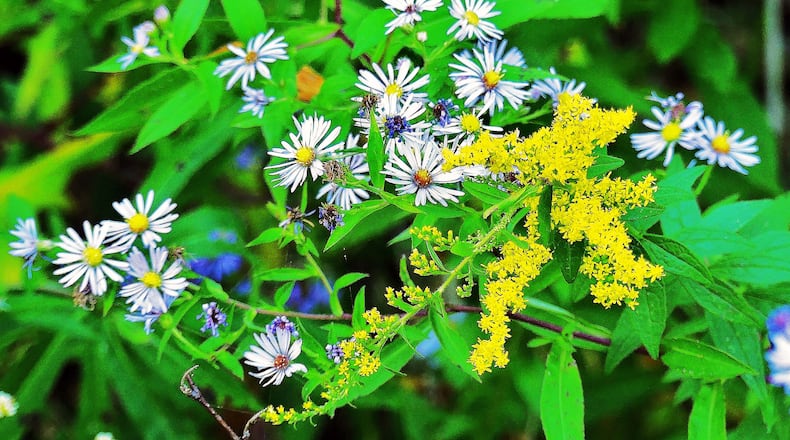I can’t imagine September without goldenrods and asters, whose beautiful blooms I most associate with late summer and fall in Georgia. A September without them would be like early April without dogwood blossoms.
Goldenrods and asters seem to go together, like salt and pepper and horse and carriage. This month, they’ll be exploding into riots of color along roadsides and forest edges, in woodland openings, meadows, old fields and along stream banks. (Georgia has some 30 goldenrod species and about 35 aster species.)
Some of nature’s most breathtaking sights in autumn are bright yellow goldenrods blooming next to blue, white or purple asters in sunny fields and along country lanes. It’s no coincidence that species of the two groups often bloom together in the same place at the same time. The two groups are closely related, both belonging to the aster family.
Their bright colors seem designed by nature to blend just right to produce pleasing visual effects. That’s especially true when blue or purple asters bloom among yellow goldenrods. Blue or purple with yellow are said to be “complementary” colors that, when viewed together, are satisfying to the eye.
In her bestselling book, “Braiding Sweetgrass,” author Robin Wall Kimmerer said she decided early on to study botany because she wanted to find out why goldenrods and asters grow together.
She asked: Why do they stand beside each other when they could grow alone? Her conclusion: Goldenrod and aster colors mixed together also are pleasing to the eyes of bees, flies and other vital pollinators. It makes the flowers prime pollinator targets. Together, their blooms receive far more pollinator visits than they would if growing alone.
One would find it hard to argue that point after observing the amazing profusion of bees, flies, wasps, butterflies and other pollinators buzzing about and sipping nectar from goldenrods and asters on a sunny day in fall.
Come first frost, though, their flowers will wither and turn dull brown. Even then, their seeds will provide food for many birds and small animals.
IN THE SKY: From David Dundee, Tellus Science Museum astronomer: The moon is first quarter on Saturday night (Sept. 3). Mercury is low in the west at dusk. Rising in the east are Venus, just before sunrise; Mars, around midnight; Jupiter, just after dark; and Saturn, at sunset.
Charles Seabrook can be reached at charles.seabrook@yahoo.com.
About the Author
Keep Reading
The Latest
Featured


